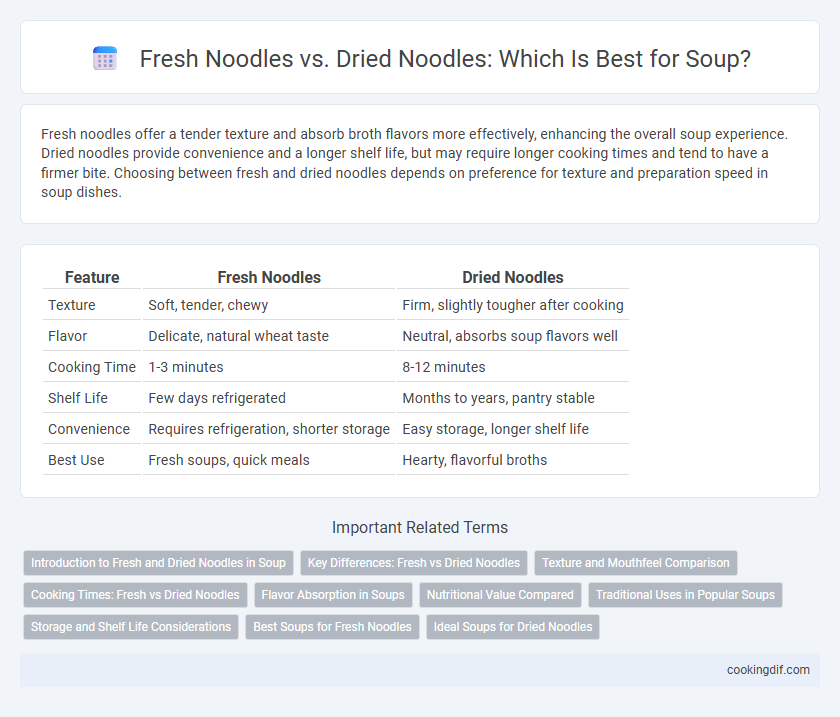Fresh noodles offer a tender texture and absorb broth flavors more effectively, enhancing the overall soup experience. Dried noodles provide convenience and a longer shelf life, but may require longer cooking times and tend to have a firmer bite. Choosing between fresh and dried noodles depends on preference for texture and preparation speed in soup dishes.
Table of Comparison
| Feature | Fresh Noodles | Dried Noodles |
|---|---|---|
| Texture | Soft, tender, chewy | Firm, slightly tougher after cooking |
| Flavor | Delicate, natural wheat taste | Neutral, absorbs soup flavors well |
| Cooking Time | 1-3 minutes | 8-12 minutes |
| Shelf Life | Few days refrigerated | Months to years, pantry stable |
| Convenience | Requires refrigeration, shorter storage | Easy storage, longer shelf life |
| Best Use | Fresh soups, quick meals | Hearty, flavorful broths |
Introduction to Fresh and Dried Noodles in Soup
Fresh noodles in soup offer a tender texture and quick cooking time, enhancing the broth's flavor with their delicate absorbency, while dried noodles provide a firmer bite and longer shelf life, making them ideal for hearty, slow-cooked soups. The moisture content in fresh noodles typically ranges from 30% to 40%, contributing to their softness, whereas dried noodles contain less than 15% moisture, resulting in a chewier consistency. Both noodle types interact differently with soup ingredients, with fresh noodles absorbing flavors rapidly and dried noodles maintaining structural integrity during extended simmering.
Key Differences: Fresh vs Dried Noodles
Fresh noodles have a soft texture and absorb soup flavors quickly, making them ideal for delicate broths, while dried noodles offer longer shelf life and a firmer bite that holds well in hearty soups. The moisture content in fresh noodles allows for quicker cooking, contrasting with the longer boiling time needed for dried varieties, which maintain structural integrity in rich, robust soups. Nutritionally, fresh noodles retain more moisture and subtle wheat flavors, whereas dried noodles provide convenience and consistent quality across diverse soup recipes.
Texture and Mouthfeel Comparison
Fresh noodles offer a tender, chewy texture that absorbs soup flavors quickly, enhancing the overall mouthfeel with a soft, springy bite. Dried noodles provide a firmer, more resilient texture, adding a slightly al dente quality that holds up well in hot broths without becoming mushy. The choice between fresh and dried noodles significantly impacts the soup's sensory experience, balancing softness and bite according to preference.
Cooking Times: Fresh vs Dried Noodles
Fresh noodles cook significantly faster than dried noodles, typically requiring just 2 to 3 minutes in boiling water due to their higher moisture content. Dried noodles, dehydrated for long shelf life, usually need 8 to 12 minutes of cooking to achieve the desired texture. Understanding these timing differences helps optimize soup preparation, ensuring noodles are neither undercooked nor mushy.
Flavor Absorption in Soups
Fresh noodles absorb soup flavors more effectively due to their porous texture and higher moisture content, allowing broth to penetrate deeper. Dried noodles, being denser and less porous, tend to retain their own flavor and absorb less of the soup's essence. This difference makes fresh noodles ideal for richly flavored soups where enhanced broth integration is desired.
Nutritional Value Compared
Fresh noodles contain higher moisture levels and retain more nutrients like B vitamins and antioxidants, making them a nutritious choice for soups. Dried noodles offer longer shelf life but typically undergo nutrient loss during processing, especially in heat-sensitive vitamins. In soup applications, fresh noodles enhance both texture and nutritional content compared to dried varieties.
Traditional Uses in Popular Soups
Fresh noodles retain moisture and offer a tender texture ideal for traditional Asian soups like Vietnamese Pho and Japanese Ramen, where the delicate broth complements their subtle flavor. Dried noodles provide a firmer bite and longer shelf life, commonly used in hearty soups such as Italian Minestrone and Chinese hot and sour soup, absorbing robust flavors effectively. The choice between fresh and dried noodles depends on the soup's cooking time and desired texture authenticity in regional culinary practices.
Storage and Shelf Life Considerations
Fresh noodles for soup offer a shorter shelf life, typically lasting only a few days when refrigerated due to their high moisture content, requiring immediate consumption or freezing for extended storage. Dried noodles, with a moisture content below 12%, provide an extended shelf life of up to a year or more when stored in a cool, dry place, making them ideal for long-term pantry stocking. Proper storage conditions significantly impact both types; airtight containers prevent moisture absorption in dried noodles and freezer-safe packaging preserves texture and flavor in fresh noodles.
Best Soups for Fresh Noodles
Fresh noodles retain a tender, silky texture that enhances the mouthfeel and absorbs broth flavors more effectively, making them ideal for light, clear soups like wonton or chicken broth. Their higher moisture content allows for quicker cooking, preserving delicate ingredients and subtle seasonings. Fresh noodles complement Asian soups that emphasize freshness and simplicity, providing a vibrant eating experience unmatched by dried varieties.
Ideal Soups for Dried Noodles
Dried noodles are ideal for hearty soups like ramen, beef noodle soup, and spicy tom yum due to their firm texture that holds up well in prolonged cooking. These noodles absorb flavors effectively without becoming mushy, enhancing the broth's richness. Their long shelf life and convenience make them a perfect choice for robust, flavorful soup recipes.
Fresh noodles vs dried noodles for soup Infographic

 cookingdif.com
cookingdif.com